Search results for: 'Römische den'
-
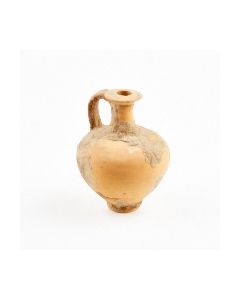 Roman terracotta jar
Roman terracotta jarFound between 1978 and 1984 in the area of the limes forts Pförring, Eining, Pfünz, Kösching and Weißenburg. Perfectly preserved.
Price: on request Colorful Roman glass balsamarium
Colorful Roman glass balsamariumThe small flask was probably used for perfume or other scented oils. This type of vessel was used throughout the Roman trade markets. The play of colours on the surface is wonderful.
Price: on request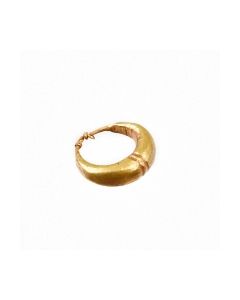 Graeco-Roman earring
Graeco-Roman earringThe decorated earrings is made of gold sheet. It is hollow inside. The type is from Northern Africa and dates to Greek or Roman times.
Price: on request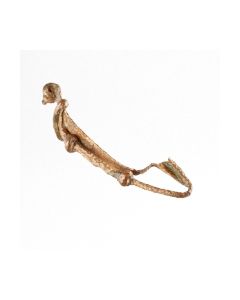 Celtic fibula from the famous Hattatt collection
Celtic fibula from the famous Hattatt collectionFibula from the La Tène II period. Found in Celtic Carnuntum. The piece is published in the standard work "Iron Age and Roman Brooches".
Price: on request Stamped Roman tile found in Trier
Stamped Roman tile found in TrierThe tile belongs to the ADIVTE/ADIVTICE group and was produced in the late 3rd or early 4th century AD. Found in Trier, Germany.
Price: on request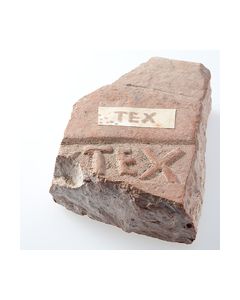 Stamped Roman tile
Stamped Roman tileThe tile belong to the ADIVTE/ADIVTICE group. Very deep and perfecty preserved stamp. Reported to have been found in Trier, Germany.
Price: on request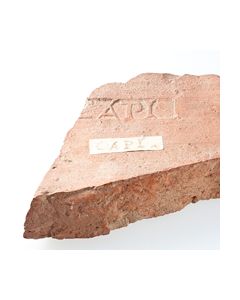 Stamped Roman tile found in Treves
Stamped Roman tile found in TrevesPerfectly preserved with deeply carved stamp. From the CAPIONACI group.
Price: on request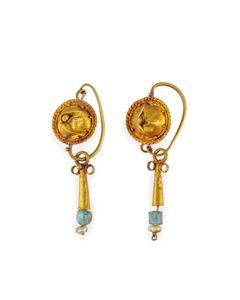 Goldohrringpaar
GoldohrringpaarWunderschöne antike Ohrringe aus Gold. Römische Zeit.
Price: on request Antike Riemenzunge
Antike RiemenzungeVermutlich Teil eines Zaumzeugs. Vollständig erhalten, sehr schöne Patina. Wohl 1. Jh. n. Chr. bis 4. Jh. n. Chr. Fund aus Deutschland aus den 1970er Jahren.
Price: on request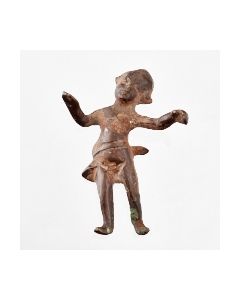 Roman bronze from famous "Museum fuer Morgenlandfahrer"
Roman bronze from famous "Museum fuer Morgenlandfahrer"Massive bronze figurine of a dancing boy, beautiful dark patina, 1st-2nd century AD
Price: on request Graeco-Roman earrings
Graeco-Roman earringsThe pair of earrings is made of gold. The type is from Northern Africa and dates to Greek or Roman times.
Price: on request Boden eines Tongefäßes mit Stempel VOMIV
Boden eines Tongefäßes mit Stempel VOMIVAuf der Unterseite Notiz Belgia mit schwarzem Stift. Kein Belegstück gefunden, möglicherweise selten oder bislang unbekannt.
Price: on request Graeco-Roman earrings
Graeco-Roman earringsThe decorated pair of earrings is made of gold sheet. It is hollow inside. The type is from Northern Africa and dates to Greek or Roman times.
Price: on request Roman marble inscribed stele with funereal scene
Roman marble inscribed stele with funereal sceneImpressive and very fine preserved piece from an old British collection.
Price: on request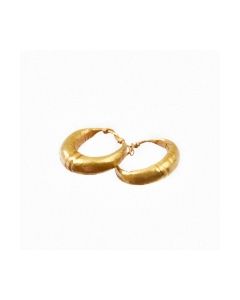 Graeco-Roman earrings
Graeco-Roman earringsThe decorated pair of earrings is made of gold sheet. It is hollow inside. The type is from Northern Africa and dates to Greek or Roman times.
Price: on request Aubergine-colored Roman glass vessel - found in a ship wreck at the Cretan coast
Aubergine-colored Roman glass vessel - found in a ship wreck at the Cretan coastElegantes Fläschchen aus wunderschönem auberginfarbenen Glas mit anhaftender, dezenter weißer Meerespatina. Das Gefäß stammt aus einem Schiffswrackfund vor der Küste der Insel Kreta.
Price: on request Roman oil lamp showing cock
Roman oil lamp showing cockVollständig erhalten, mit Spuren eines dunkelroten Überzugs. Sehr schöner Zustand mit gut erkennbarem Motiv. Römische Kaiserzeit.
Price: on request Römischer Fingerring mit Ähre
Römischer Fingerring mit ÄhreFingerring aus Silber. Ringplatte mit Ähre aus Hauptachse mit Grannen zu beiden Seiten. Das Motiv wurde in der griechischen und römischen Zeit häufig für Fingerringe verwendet. Etwa 3 Jh. n. Chr.
Price: on request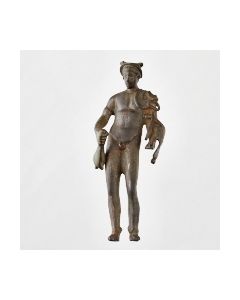 Roman bronze Mercurius (Hermes) figurine
Roman bronze Mercurius (Hermes) figurinePerfectly preserved, delicate piece of ancient art with beautiful green patina, 1st-2nd century AD
Price: on request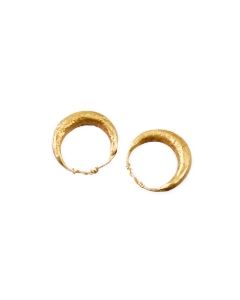 Graeco-Roman earrings
Graeco-Roman earringsThe pair of earrings is made of gold sheet. It is hollow inside. The type is from Northern Africa and dates to Greek or Roman times.
Price: on request Gallo-Roman animal fibula
Gallo-Roman animal fibulaZoomorphe Fibel mit Wildtier als Motiv. Schmuckstück mit religiöser Symbolik, vergleichbar einem Kreuzanhänger bei heutigen Christen. Gefertigt im 1. bis 3. Jh. n. Chr. in Gallien.
Price: on request Oil lamp mirror with erotic scene, piece from same workshop exhibited in Getty Museum in LA
Oil lamp mirror with erotic scene, piece from same workshop exhibited in Getty Museum in LARare type, very nicely preserved, from an old US-American collection. Ex Christie's.
Price: on request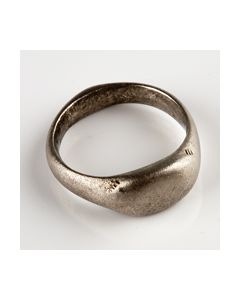 Römischer Ring aus Silber
Römischer Ring aus SilberRömische Kaiserzeit, möglicherweise aus der keltischen Provinz oder Provinznähe. Ringband geht nahtlos in die Ringplatte über. Theoretisch auch heute noch als Amulett oder Fingerring tragbar. Innendurchmesser 17mm bis 18mm.
Price: on request Roman bronze jar
Roman bronze jarMassive piece with beautiful ram head shaped handle, 1st-2nd century AD
Price: on request Gorgeous Roman Imperial fibula
Gorgeous Roman Imperial fibulaThe large bow is dominated by colourful enamel. It is a brooch type that developed during the 1st cent. AD in Central Europe.
Price: on request Roman glass beaker
Roman glass beakerThis beaker type was popular in the Holy Land during the time of Jesus Christ. But products of the local workshops were also exported.
Price: on request Spätrömische Glasflasche
Spätrömische GlasflascheElegant geformte Glasflasche mit Trichterhals und Standring. Vollständig erhalten und mit der schönen Fundpatina und fließenden Form ein beeindruckendes Objekt.
Price: on request Celtic fibula
Celtic fibulaRare fibula from the La Tène culture with beautiful enamel inlays. The main material is well preserved for an iron fibula.
Price: on request Roman provincial fibula of the horsemen
Roman provincial fibula of the horsemenThe swastika shaped brooch with horse head terminals was worn by the cavallery in Late Antiquity. In particular by the troops recruited by the Romans from their Pannonian Foederati. It might have been a symbol for strength or designated a military rank.
Price: on request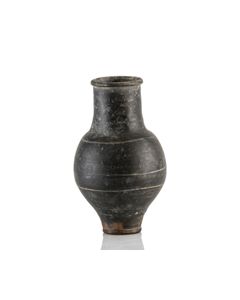 Perfectly preserved Roman beaker found 1907 in Cologne
Perfectly preserved Roman beaker found 1907 in CologneFrom the collection of the viniculture historian Friedrich von Bassermann-Jordan. Worth the exhibition in a museum.
Price: on request Glass flask in bowl
Glass flask in bowlThis uncommon glass object from Roman times consists of a household glass flask that has been set in a glass bowl. It is a mystery if it has been made for a practical purpose or if it is a trial piece of a glassblower.
Price: on request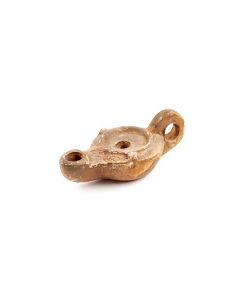 Roman oil lamp from FORTIS workshop
Roman oil lamp from FORTIS workshopRather rare type with large discus handle. From the very old German collection Becker.
Price: on request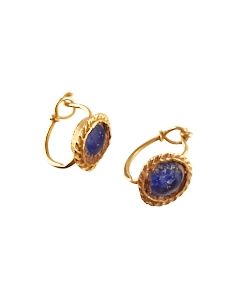 Pair of Roman gold earrings
Pair of Roman gold earringsNice golden earrings with blue glass inserts from late Roman Imperial times. It is a belonging pair of earrings which is in itself a rarity.
Price: on request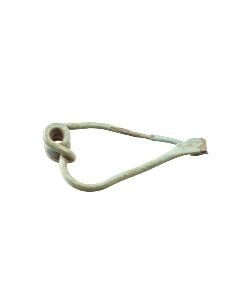 Early bow brooch of the Urnfield period
Early bow brooch of the Urnfield periodSimple fibula shape dating to the Late Bronze Age. Interesting mix of two-sided spiral spring and simple pin holder.
Price: on request Aureus des Antoninus Pius
Aureus des Antoninus PiusRom, 148 - 149 n. Chr. Aequitas steht n.l., hält Waage und Füllhorn. Vorzügliche Erhaltung, ausdrucksstarkes Portrait in hohem Relief.
Price: on request Lekythos from Toledo Museum collection
Lekythos from Toledo Museum collectionEx collection Prof. G. Olcott, the first Columbia University professor for Roman archeology. Acquired from his estate 1912 by the Toledo Museum (Ohio), in the museum collection until 2017. Found in Apulia.
Price: on request

